Color Mechanism Analysis and Origin Comparison of Pink-Purple Sapphires from Vietnam and Madagascar
Abstract
1. Introduction
2. Geological Setting
3. Materials and Methods
3.1. Sample Description
3.2. Conventional Gemological Testing
3.3. Microscopic Analysis and Spectroscopy
3.4. Chemical Analysis
4. Results
4.1. Gemological Properties and Internal Features
4.2. Spectra Analysis
4.2.1. FTIR Spectra
4.2.2. UV–Vis–NIR Spectra
4.2.3. Raman Spectra
4.3. Chemical Compositions
5. Discussion
5.1. Analysis of the Coloration Mechanism and Special Appearance of Pink-Purple Sapphires
5.2. Origin Identification
5.2.1. Inclusions
5.2.2. Chemical Composition Analysis
6. Conclusions
Author Contributions
Funding
Data Availability Statement
Acknowledgments
Conflicts of Interest
Appendix A
| Elements (ppm) | Detection Limits |
|---|---|
| Mg | 0.73 |
| Ti | 0.44 |
| V | 0.08 |
| Cr | 1.76 |
| Fe | 25.55 |
| Ga | 0.12 |
References
- Pornwilard, M.M.; Hansawek, R.; Shiowatana, J.; Siripinyanond, A. Geographical Origin Classification of Gem Corundum Using Elemental Fingerprint Analysis by Laser Ablation Inductively Coupled Plasma Mass Spectrometry. Int. J. Mass Spectrom. 2011, 306, 57–62. [Google Scholar] [CrossRef]
- Sutherland, F.; Zaw, K.; Meffre, S.; Thompson, J.; Goemann, K.; Thu, K.; Nu, T.; Zin, M.; Harris, S. Diversity in Ruby Geochemistry and Its Inclusions: Intra- and Inter- Continental Comparisons from Myanmar and Eastern Australia. Minerals 2019, 9, 28. [Google Scholar] [CrossRef]
- Li, E.; Xu, B. Gemological and Chemical Composition Characteristics of Basalt-Related Rubies from Chanthaburi-Trat, Thailand. Crystals 2023, 13, 1179. [Google Scholar] [CrossRef]
- Cooper, A.; Palke, A.C. Rare Intense Purplish Pink Montana SAPPHIRE. Gems Gemol. 2020, 56, 522. [Google Scholar]
- Rakotondrazafy, A.F.M.; Giuliani, G.; Ohnenstetter, D.; Fallick, A.E.; Rakotosamizanany, S.; Andriamamonjy, A.; Ralantoarison, T.; Razanatseheno, M.; Offant, Y.; Garnier, V.; et al. Gem Corundum Deposits of Madagascar: A Review. Ore Geol. Rev. 2008, 34, 134–154. [Google Scholar] [CrossRef]
- Winotai, P.; Wichan, T.; Tang, I.M.; Yaokulbode, J. Heat treatments of Tanzania ruby as monitored by ESR spectroscopy. Int. J. Mod. Phys. B 2000, 14, 1693–1700. [Google Scholar] [CrossRef]
- Nassau, K. Heat Treating Ruby and Sapphire: Technical Aspects. Gems Gemol. 1981, 17, 121–131. [Google Scholar] [CrossRef]
- Giuliani, G.; Groat, L.A. Geology of Corundum and Emerald Gem Deposits: A Review. Gems Gemol. 2019, 55, 464–489. [Google Scholar] [CrossRef]
- Palke, A.C.; Saeseaw, S.; Renfro, N.D.; Sun, Z.; McClure, S.F. Geographic Origin Determination of Ruby. Gems Gemol. 2019, 55, 580–613. [Google Scholar] [CrossRef]
- Giuliani, G.; Ohnenstetter, D.; Fallick, A.E.; Groat, L.; Fagan, A. The Geology and Genesis of Gem Corundum Deposits. In Geology of Gem Deposits; Mineralogical Association of Canada: Sudbury, ON, Candada, 2014; ISBN 978-0-921294-54-2. [Google Scholar]
- Devouard, B.; Notari, F. The Identification of Faceted Gemstones: From the Naked Eye to Laboratory Techniques. Elements 2009, 5, 163–168. [Google Scholar] [CrossRef]
- Rossman, G.R. The Geochemistry of Gems and Its Relevance to Gemology: Different Traces, Different Prices. Elements 2009, 5, 159–162. [Google Scholar] [CrossRef]
- Giuliani, G.; Fallick, A.; Rakotondrazafy, M.; Ohnenstetter, D.; Andriamamonjy, A.; Ralantoarison, T.; Rakotosamizanany, S.; Razanatseheno, M.; Offant, Y.; Garnier, V.; et al. Oxygen isotope systematics of gem corundum deposits in Madagascar: Relevance for their geological origin. Miner. Depos. 2007, 42, 251–270. [Google Scholar] [CrossRef]
- Kochelek, K.; Mcmillan, N.; McManus, C.; Daniel, D. Provenance Determination of Sapphires and Rubies Using Laser-Induced Breakdown Spectroscopy and Multivariate Analysis. Am. Mineral. 2015, 100, 1921–1931. [Google Scholar] [CrossRef]
- Keulen, N.; Thomsen, T.B.; Schumacher, J.C.; Poulsen, M.D.; Kalvig, P.; Vennemann, T.; Salimi, R. Formation, Origin and Geographic Typing of Corundum (Ruby and Pink Sapphire) from the Fiskenæsset Complex, Greenland. Lithos 2020, 366–367, 105536. [Google Scholar] [CrossRef]
- Sutherland, F.L.; Giuliani, G.; Fallick, A.E.; Garland, M.; Webb, G. Sapphire–ruby characteristics west Pailin, Cambodia. Aust. Gemol. 2008, 23, 329–368. Available online: https://www.researchgate.net/publication/285867432_Sapphire-ruby_characteristics_west_Pailin_Cambodia (accessed on 2 November 2024).
- Smith, C.P. Rubies and pink sapphires from the Pamir Mountain Range in Tajikistan, former USSR. Gemmology 1998, 26, 104–109. Available online: https://gem-a.com/wp-content/uploads/2023/11/JoG1998_26_2.pdf#page=41 (accessed on 3 November 2024). [CrossRef]
- Santosh, M.; Katori, R.; Yoshikura, S.; Higash, S.; Salim, A.K. Pink Sapphire from Southern Kerala, S. India: Implications on India-Madagascar Correlation Within Gondwana Assembly. Gondwana Res. 2002, 5, 894–901. [Google Scholar] [CrossRef]
- Saminpanya, S.; Sutherland, F.L. Different Origins of Thai Area Sapphire and Ruby, Derived from Mineral Inclusions and Co-Existing Minerals. Eur. J. Mineral. 2011, 23, 683–694. [Google Scholar] [CrossRef]
- Kane, R.E.; McClure, S.F.; Kammerling, R.C.; Khoa, N.D.; Mora, C.; Repetto, S.; Khai, N.D.; Koivula, J.I. Rubies and Fancy Sapphires from Vietnam. Gems Gemol. 1991, 27, 136–155. [Google Scholar] [CrossRef]
- Khoi, N.N.; Sutthirat, C.; Tuan, D.A.; Van Nam, N.; Thuyet, N.T.M.; Nhung, N.T. Ruby and Sapphire from the Tan Huong-Truc Lau Area, Yen Bai Province, Northern Vietnam. Gems Gemol. 2011, 47, 182–195. [Google Scholar] [CrossRef]
- Karampelas, S.; Hennebois, U.; Mevellec, J.-Y.; Pardieu, V.; Delaunay, A.; Fritsch, E. Pink to Purple Sapphires from Ilakaka, Madagascar: Insights to Separate Unheated from Heated Samples. Minerals 2023, 13, 704. [Google Scholar] [CrossRef]
- Garnier, V.; Ohnenstetter, D.; Giuliani, G.; Maluski, H.; Deloule, E.; Trong, T.P.; Van, L.P.; Quang, V.H. Age and Significance of ruby-bearing marble from the red river shear zone, northern Vietnam. Can. Mineral. 2005, 43, 1315–1329. [Google Scholar] [CrossRef]
- Leloup, P.H.; Arnaud, N.; Lacassin, R.; Kienast, J.R.; Harrison, T.M.; Trong, T.T.P.; Replumaz, A.; Tapponnier, P. New Constraints on the Structure, Thermochronology, and Timing of the Ailao Shan-Red River Shear Zone, SE Asia. J. Geophys. Res. 2001, 106, 6683–6732. [Google Scholar] [CrossRef]
- Zhang, J.; Lu, T.; Chen, H. Characteristics of Coated Jadeite Jade. Gems Gemol. 2014, 49, 246–251. [Google Scholar] [CrossRef]
- Hughes, E.B.; Perkins, R. Madagascar Sapphire: Low-Temperature Heat Treatment Experiements. Gems Gemol. 2019, 55, 184–197. [Google Scholar] [CrossRef]
- Pardieu, V.; Vertriest, W.; Weeramonkhonlert, V.; Raynaud, V.; Atikarnsakul, U.; Perkins, R. Sapphires from the Gem Rush Bemainty Area, Ambatondrazaka (Madagascar); GIA Laboratory: Bangkok, Thailand, 2017. [Google Scholar]
- GIA Field Gemology Team Explores Sapphire Mines at Ilakaka, Madagascar. Available online: https://www.gia.edu/gia-news-research/sapphire-mines-ilakaka-madagascar-field-expedition (accessed on 13 November 2024).
- Xu, B.; Yin, R.-S.; Chiaradia, M.; Miao, Z.; Griffin, W.L.; Hou, Z.-Q.; Yang, Z.-M.; O’Reilly, S.Y. Mercury Isotope Evidence for the Importance of Recycled Fluids in Collisional Ore Systems. Sci. Adv. 2024, 10, eadp7383. [Google Scholar] [CrossRef]
- Xu, B.; Hou, Z.-Q.; Griffin, W.L.; Zheng, Y.-C.; Wang, T.; Guo, Z.; Hou, J.; Santosh, M.; O’Reilly, S.Y. Cenozoic Lithospheric Architecture and Metallogenesis in Southeastern Tibet. Earth-Sci. Rev. 2021, 214, 103472. [Google Scholar] [CrossRef]
- Xu, B.; Hou, Z.-Q.; Griffin, W.L.; Lu, Y.; Belousova, E.; Xu, J.-F.; O’Reilly, S.Y. Recycled Volatiles Determine Fertility of Porphyry Deposits in Collisional Settings. Am. Mineral. 2021, 106, 656–661. [Google Scholar] [CrossRef]
- Xu, B.; Hou, Z.-Q.; Griffin, W.L.; Yu, J.-X.; Long, T.; Zhao, Y.; Wang, T.; Fu, B.; Belousova, E.; O’Reilly, S.Y. Apatite Halogens and Sr-O and Zircon Hf-O Isotopes: Recycled Volatiles in Jurassic Porphyry Ore Systems in Southern Tibet. Chem. Geol. 2022, 605, 120924. [Google Scholar] [CrossRef]
- Wang, A.; Kuebler, K.E.; Jolliff, B.L.; Haskin, L.A. Raman Spectroscopy of Fe-Ti-Cr-Oxides, Case Study: Martian Meteorite EETA79001. Am. Mineral. 2004, 89, 665–680. [Google Scholar] [CrossRef]
- Palke, A.C.; Saeseaw, S.; Renfro, N.D.; Sun, Z.; McClure, S.F. Geographic Origin Determination of Blue Sapphire. Gems Gemol. 2019, 55, 536–579. [Google Scholar] [CrossRef]
- Xu, W.; Krzemnicki, M. Raman Spectroscopic Investigation of Zircon in Gem-quality Sapphire: Application in Origin Determination. J. Raman Spectrosc. 2021, 52, 1011–1021. [Google Scholar] [CrossRef]
- Growth Tube Cluster in Sapphire. Gems Gemol. 2017, 53, 369–372. Available online: https://www.gia.edu/gems-gemology/fall-2017-microworld-growth-tube-cluster-sapphire (accessed on 13 November 2024).
- Giuliani, G.; Dubessy, J.; Banks, D.A.; Lhomme, T.; Ohnenstetter, D. Fluid Inclusions in Ruby from Asian Marble Deposits: Genetic Implications. Eur. J. Mineral. 2015, 27, 393–404. [Google Scholar] [CrossRef]
- Zu, E.D.; Sun, Y.D.; Zhang, P.X. The analysis of natural and synthetic ruby by Raman spectra. Spectrosc. Spectr. Anal. 2010, 30, 2164–2166. [Google Scholar] [CrossRef]
- Sorokina, E.S.; Litvinenko, A.K.; Hofmeister, W.; Häger, T.; Jacob, D.E.; Nasriddinov, Z.Z. Rubies and sapphires from Snezhnoe, Tajikistan. Gems Gemol. 2015, 51, 160–175. [Google Scholar] [CrossRef]
- Yimeng, Z.H.; Jingcheng, P.E.; Xiaojing, L.A. Gemmological and Spectral Characteristics of Ruby from Winza, Tanzania. J. Gems Gemmol. 2024, 26, 1–11. [Google Scholar] [CrossRef]
- Vertriest, W.; Saeseaw, S. A Decade of Ruby from Mozambique: A Review. Gems Gemol. 2019, 55, 162–183. [Google Scholar] [CrossRef]
- Rubies from the Montepuez Area. Available online: https://www.gia.edu/gia-rubies-from-montepuez-area (accessed on 13 November 2024).
- Leiqi, Y. Study on Gemological and Mineralogical Characteristics and Genesis of Red Corundum in Yuanjiang, Yunnan. Master’s Thesis, China University of Geosciences, Beijing, China, May 2021. [Google Scholar]
- Fengchun, L.; Yan, L.; Guyuan, D. Characteristics of low-and high-iron ruby and its significance for origin identification. Superhard Mater. Eng. 2024, 36, 62–67. [Google Scholar]
- Gao, Y.; He, M.; Lucas, A.C.; Sun, X.; Zhou, D.; Huang, T.; Li, K.; Fortaleché, D.; Lin, M.; Zhu, Y.; et al. Ruby from Longido, Tanzania: Mining, Color, Inclusion, and Chemical Features. Crystals 2024, 14, 383. [Google Scholar] [CrossRef]
- Saminpaya, S.; Manning, D.; Droop, G.T.R.; Henderson, C.M.B. Trace Elements in Thai Gem Corundums. J. Gemmol. 2003, 28, 392–398. [Google Scholar] [CrossRef]
- Chulapakorn, T.; Intarasiri, S.; Bootkul, D.; Singkarat, S. Identification of Deposit Types of Natural Corundum by PIXE. Nucl. Instrum. Methods Phys. Res. Sect. B Beam Interact. Mater. At. 2014, 331, 108–112. [Google Scholar] [CrossRef]
- Palke, A.C.; Wong, J.; Verdel, C.; Ávila, J.N. A Common Origin for Thai/Cambodian Rubies and Blue and Violet Sapphires from Yogo Gulch, Montana, USA? Am. Mineral. 2018, 103, 469–479. [Google Scholar] [CrossRef]
- Peucat, J.J.; Ruffault, P.; Fritsch, E.; Bouhnik-Le Coz, M.; Simonet, C.; Lasnier, B. Ga/Mg Ratio as a New Geochemical Tool to Differentiate Magmatic from Metamorphic Blue Sapphires. Lithos 2007, 98, 261–274. [Google Scholar] [CrossRef]
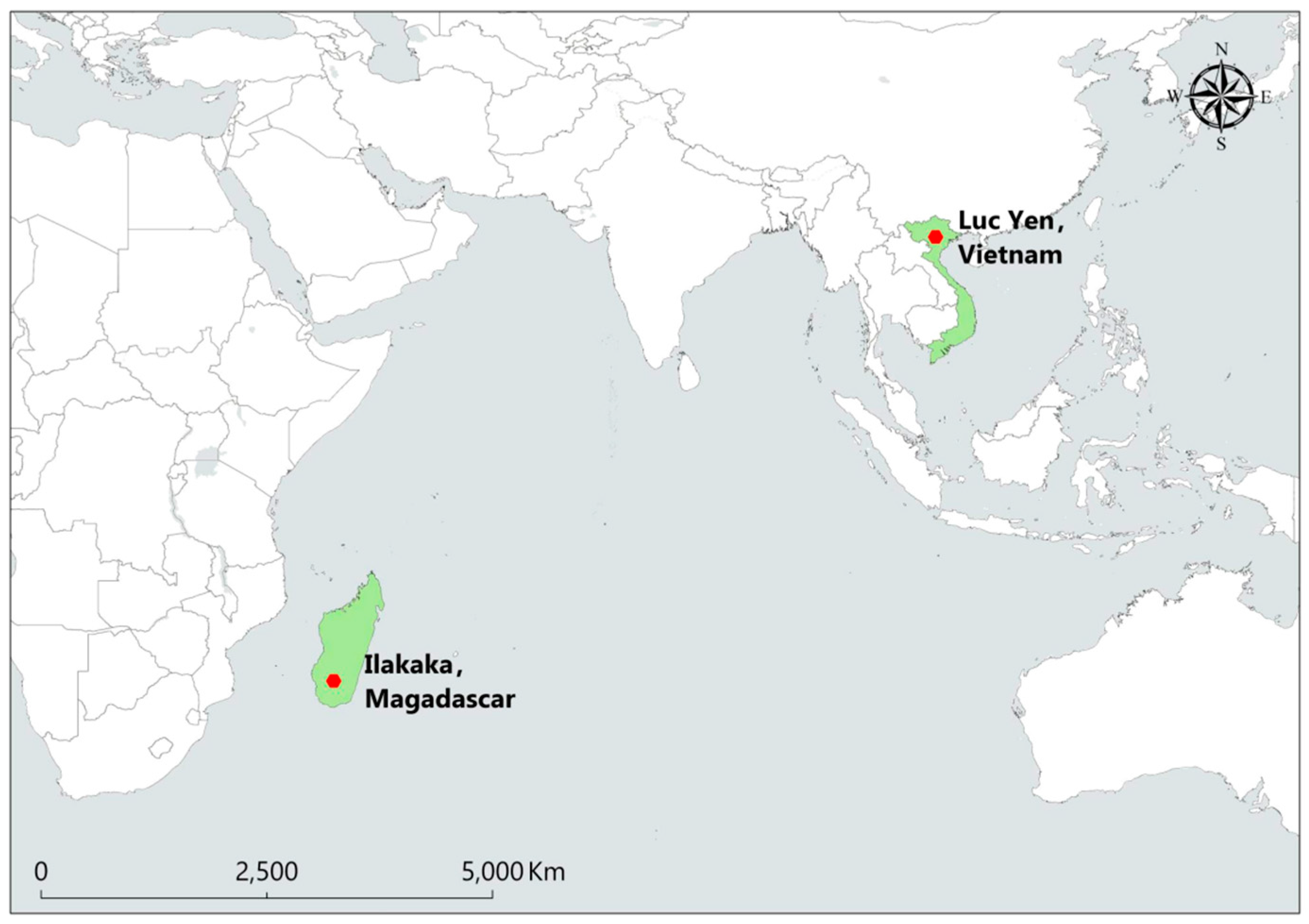
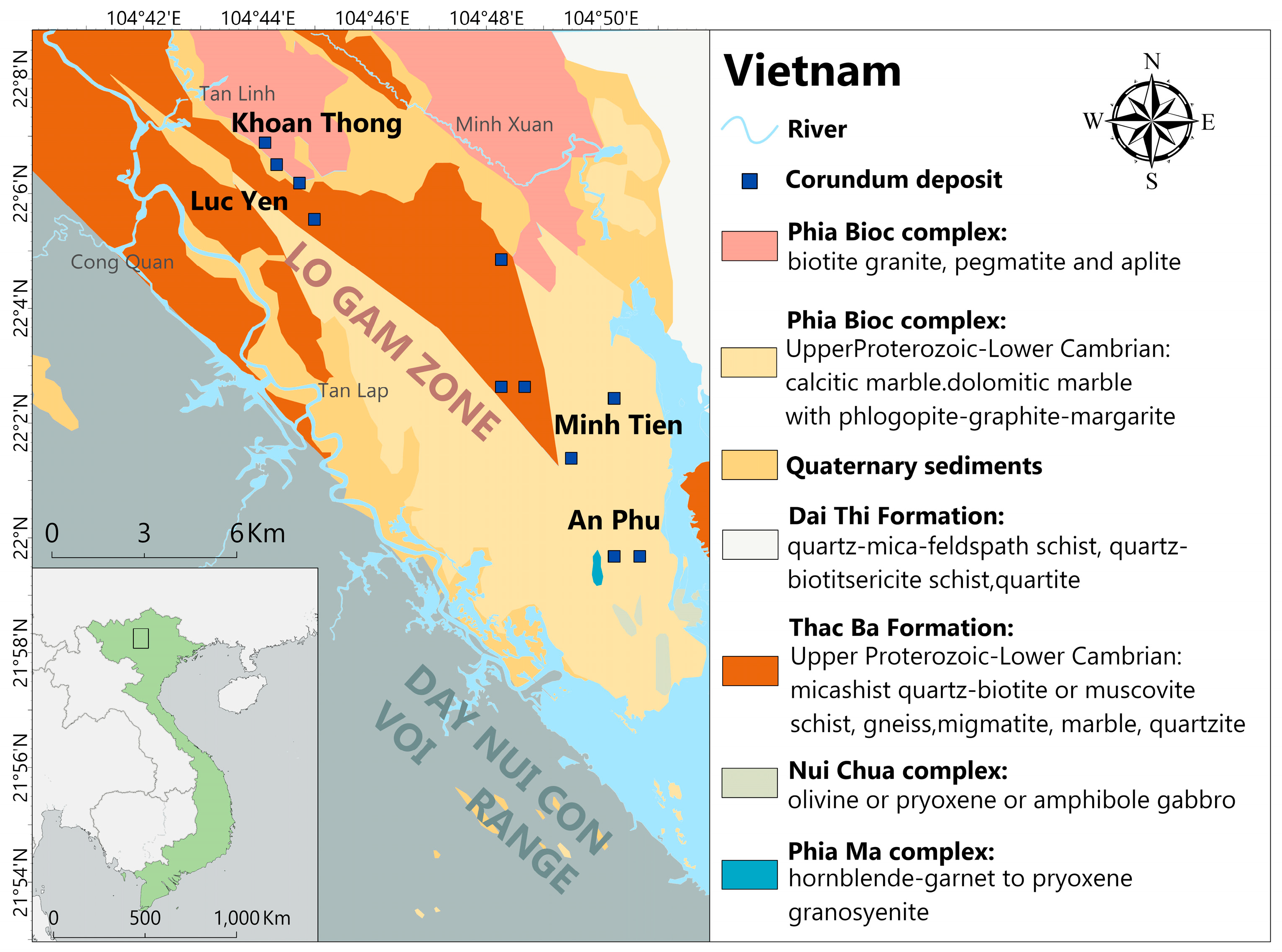
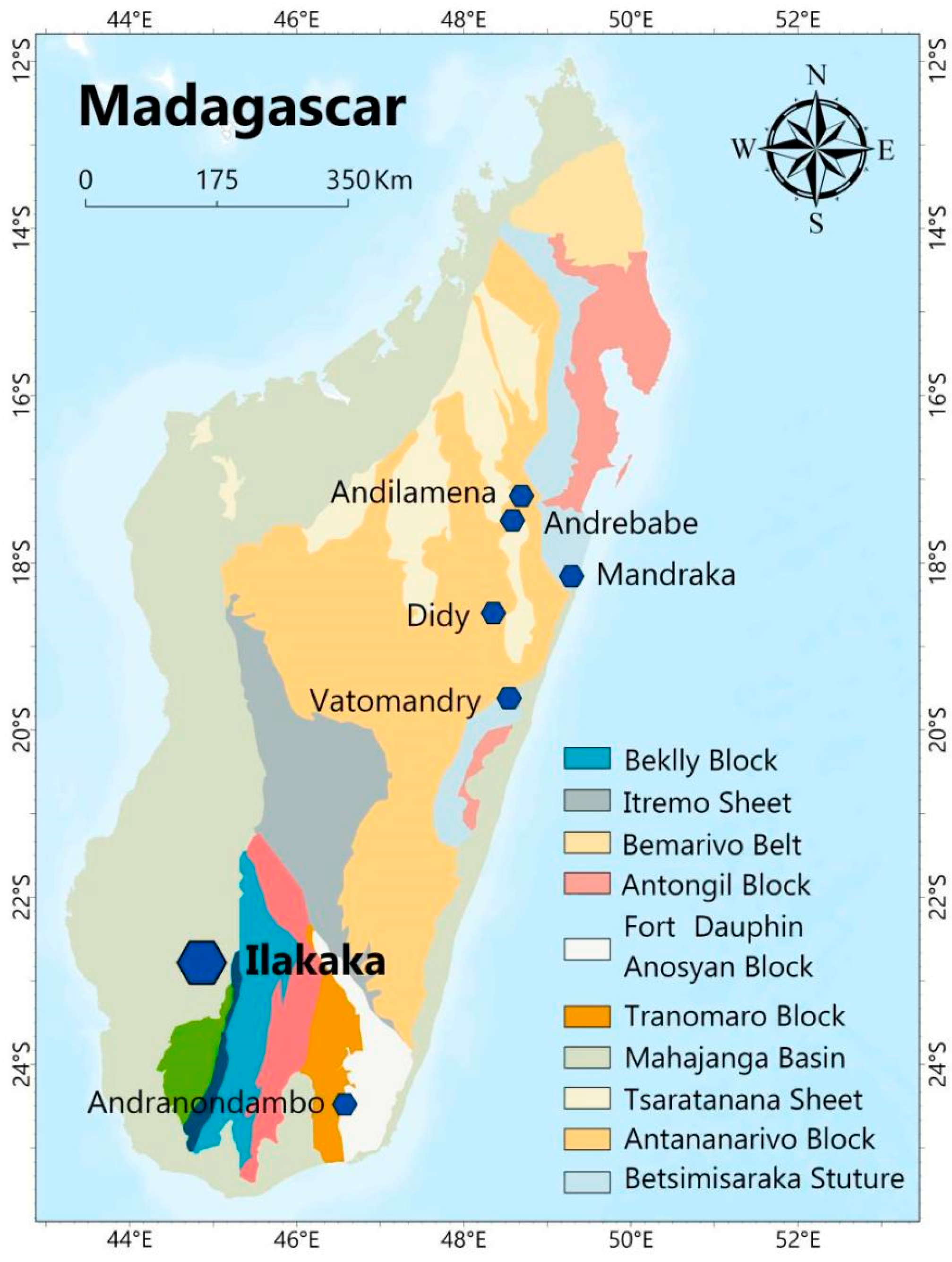

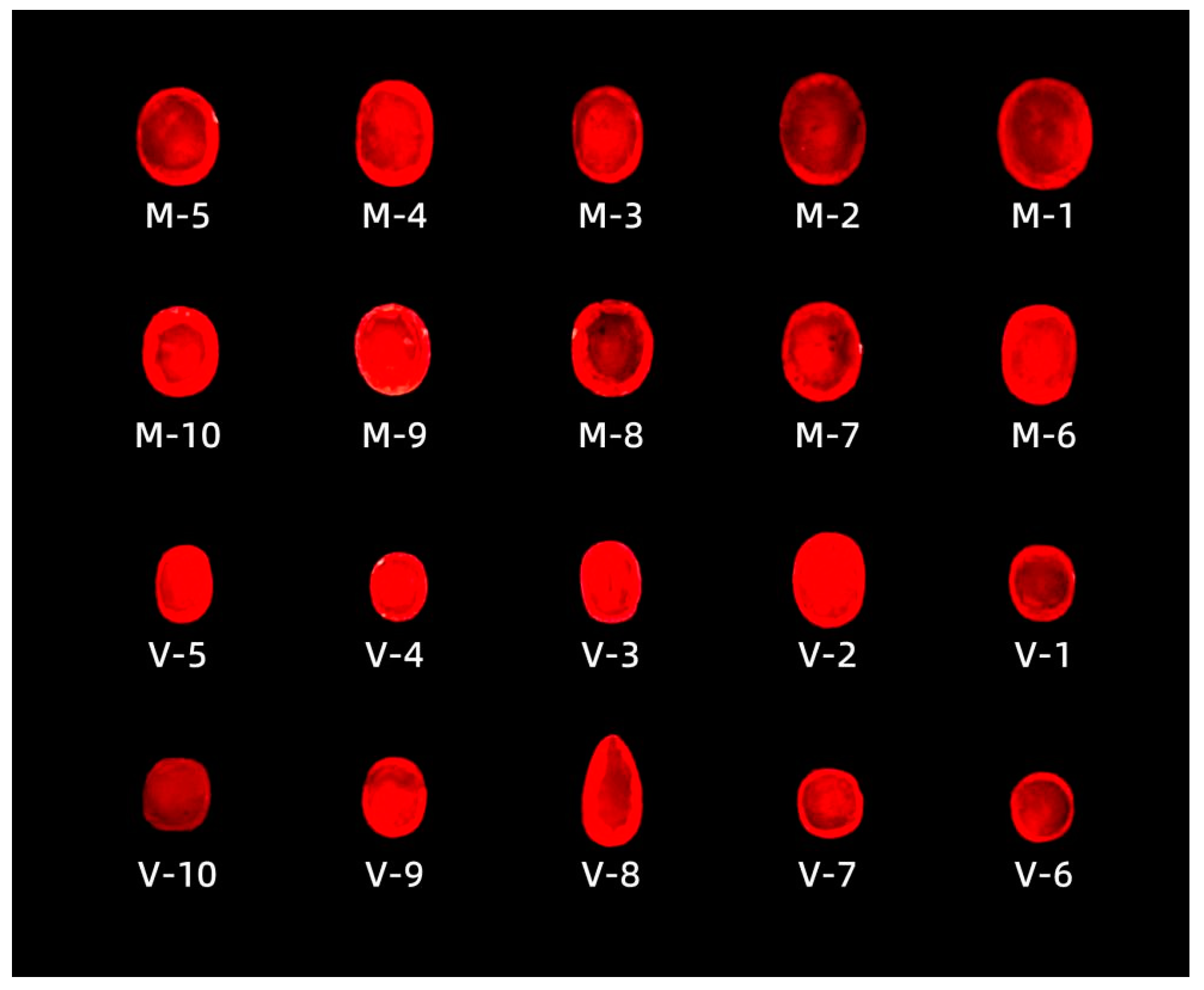
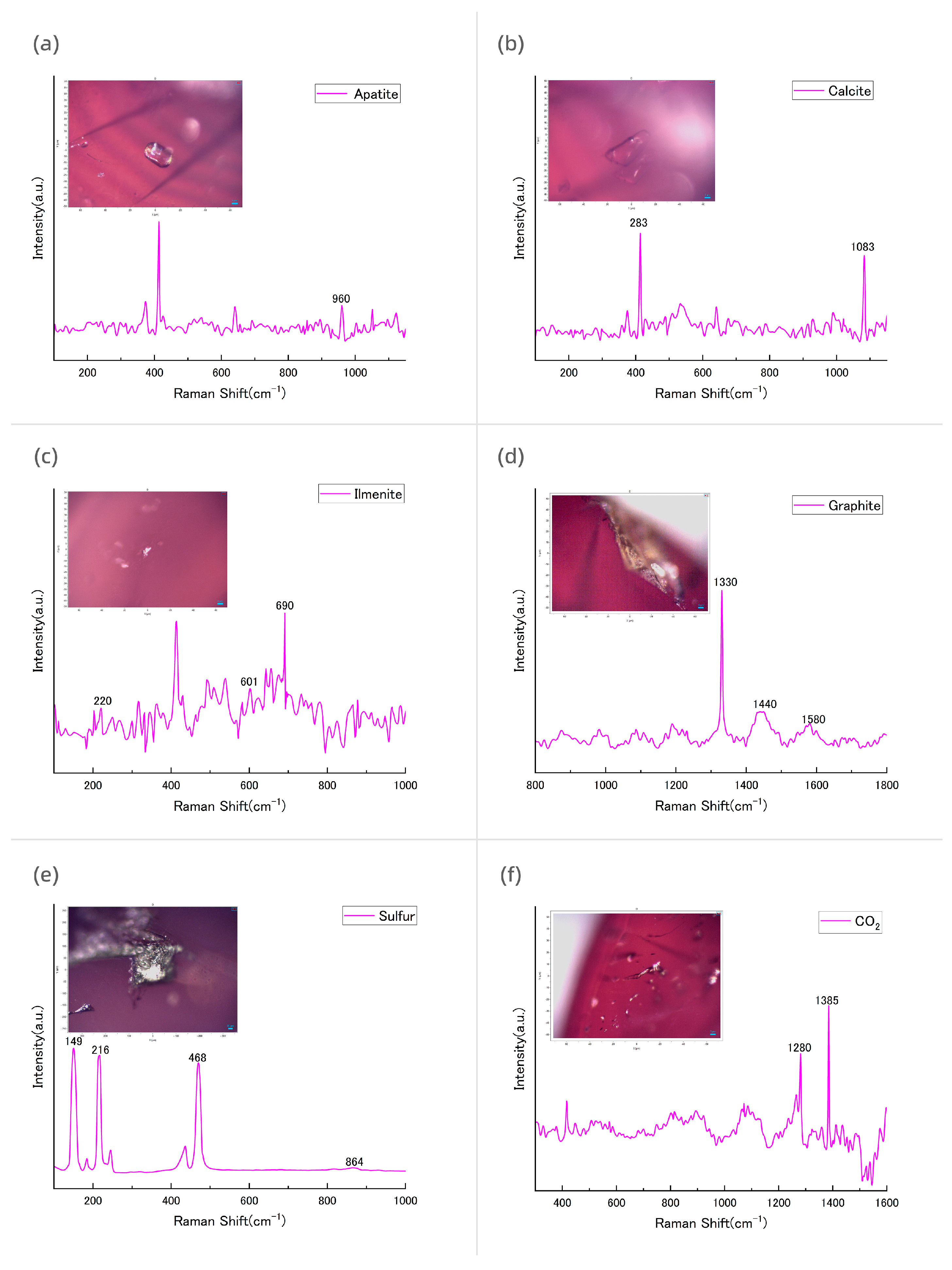
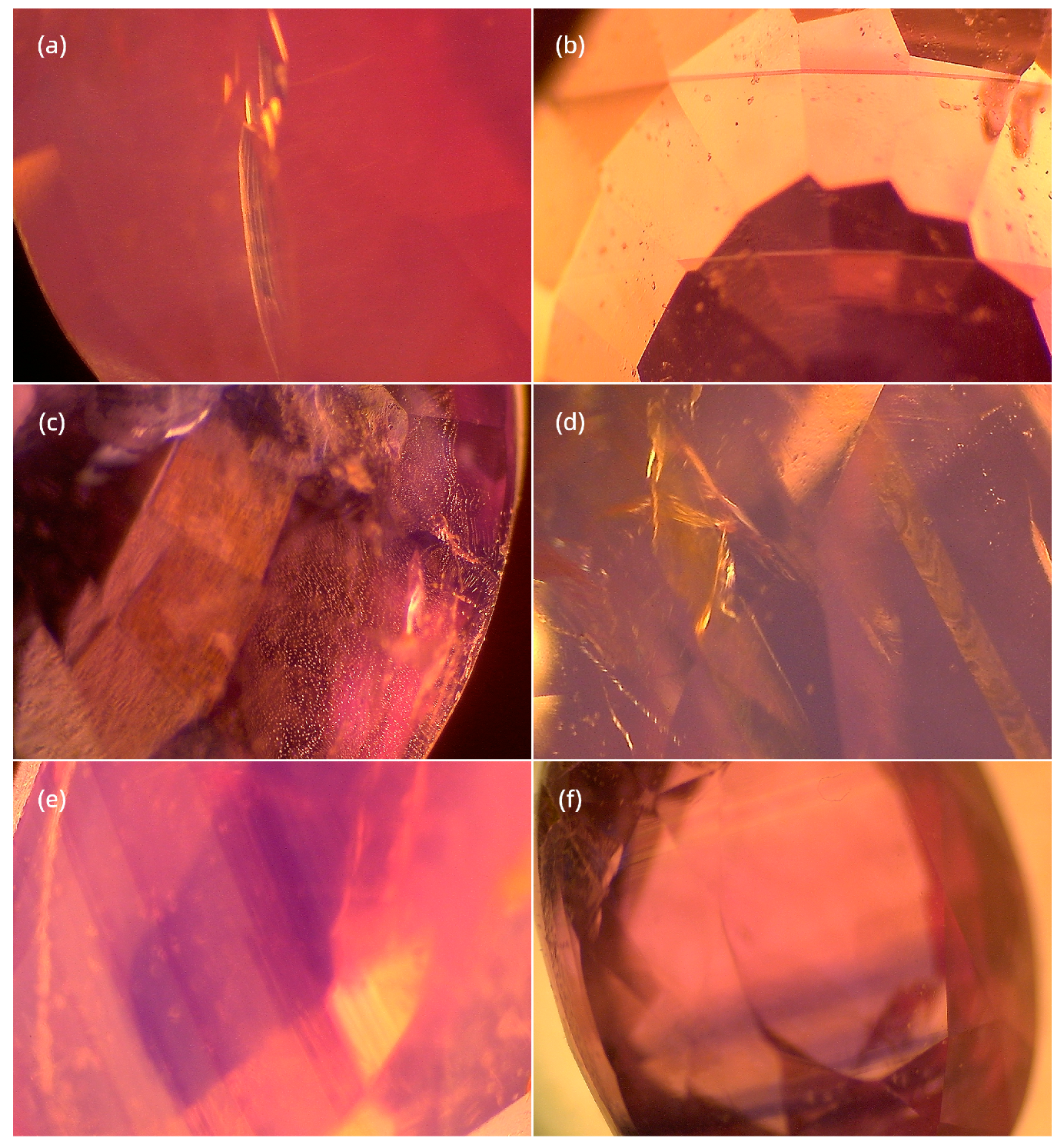


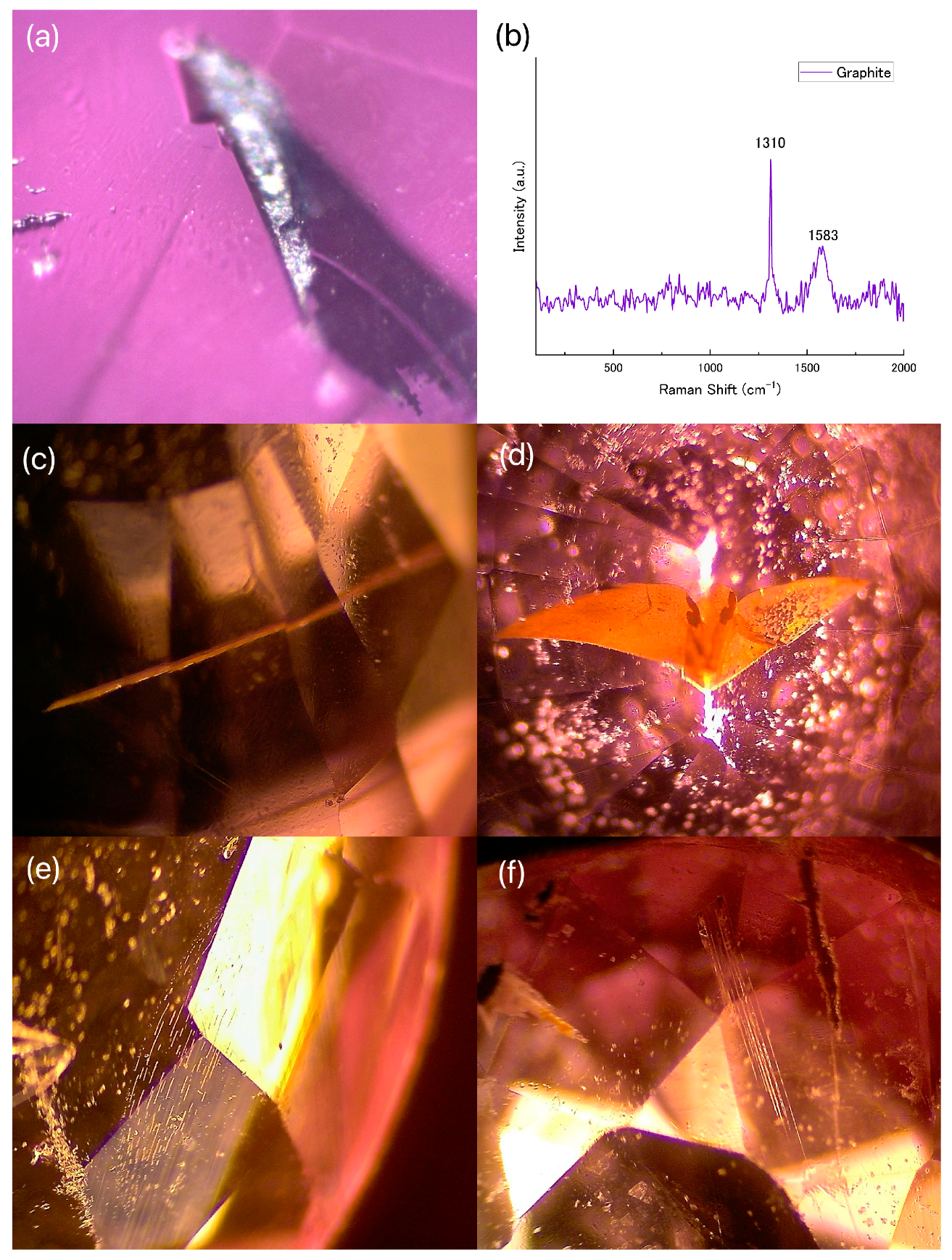
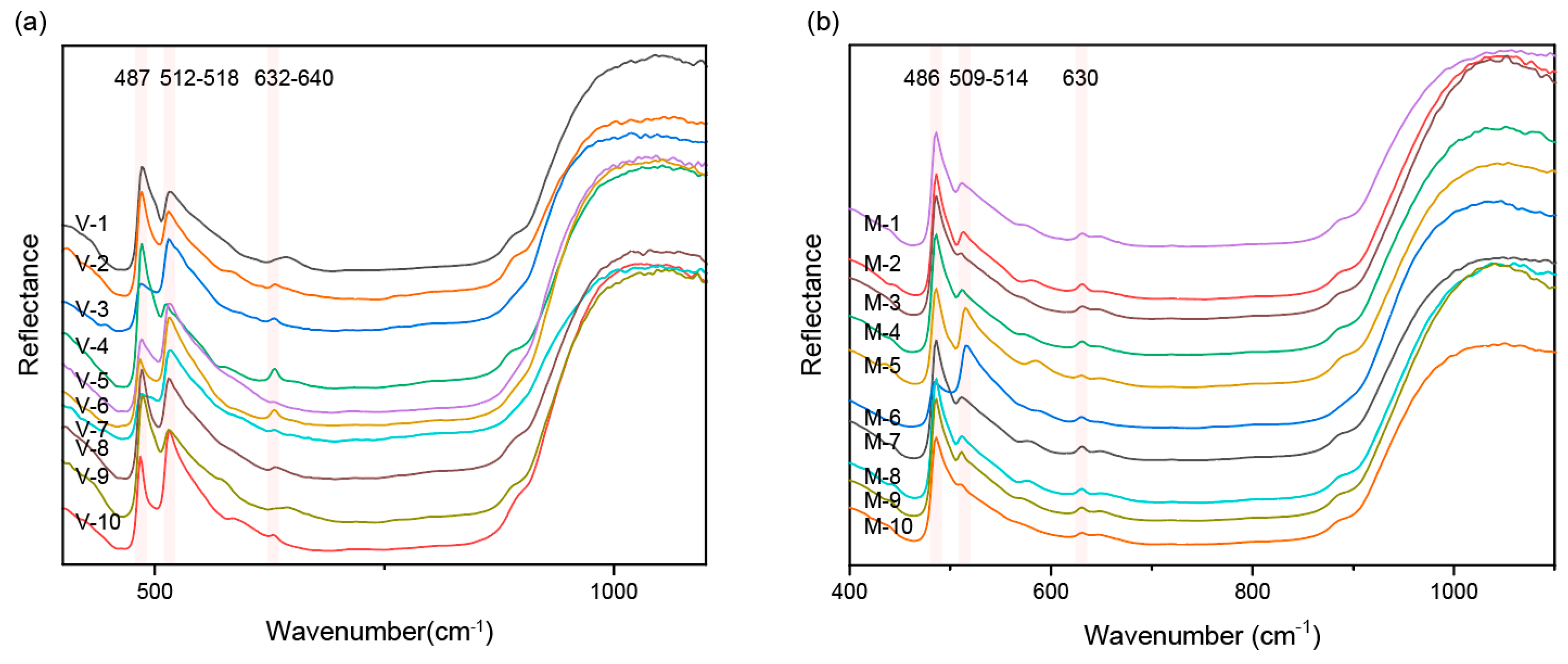

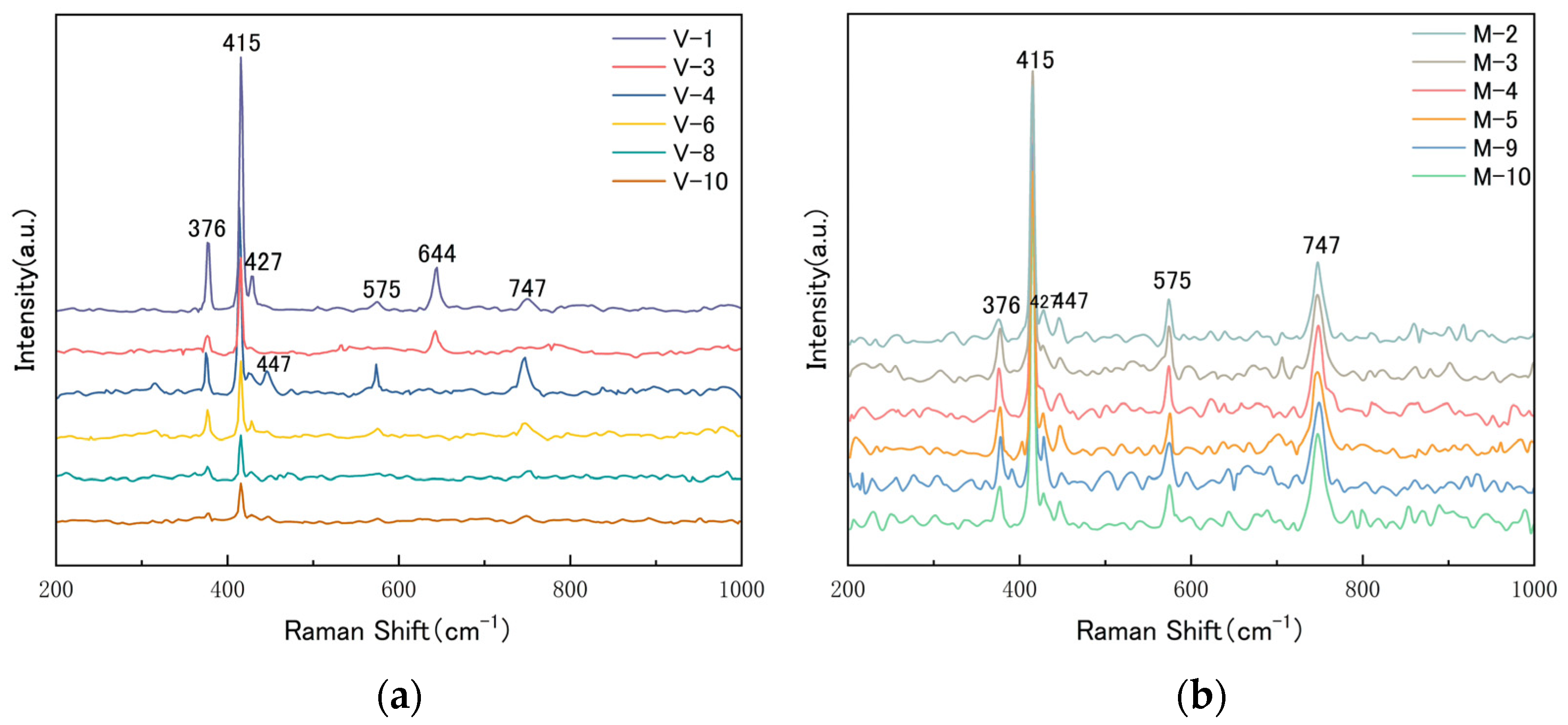
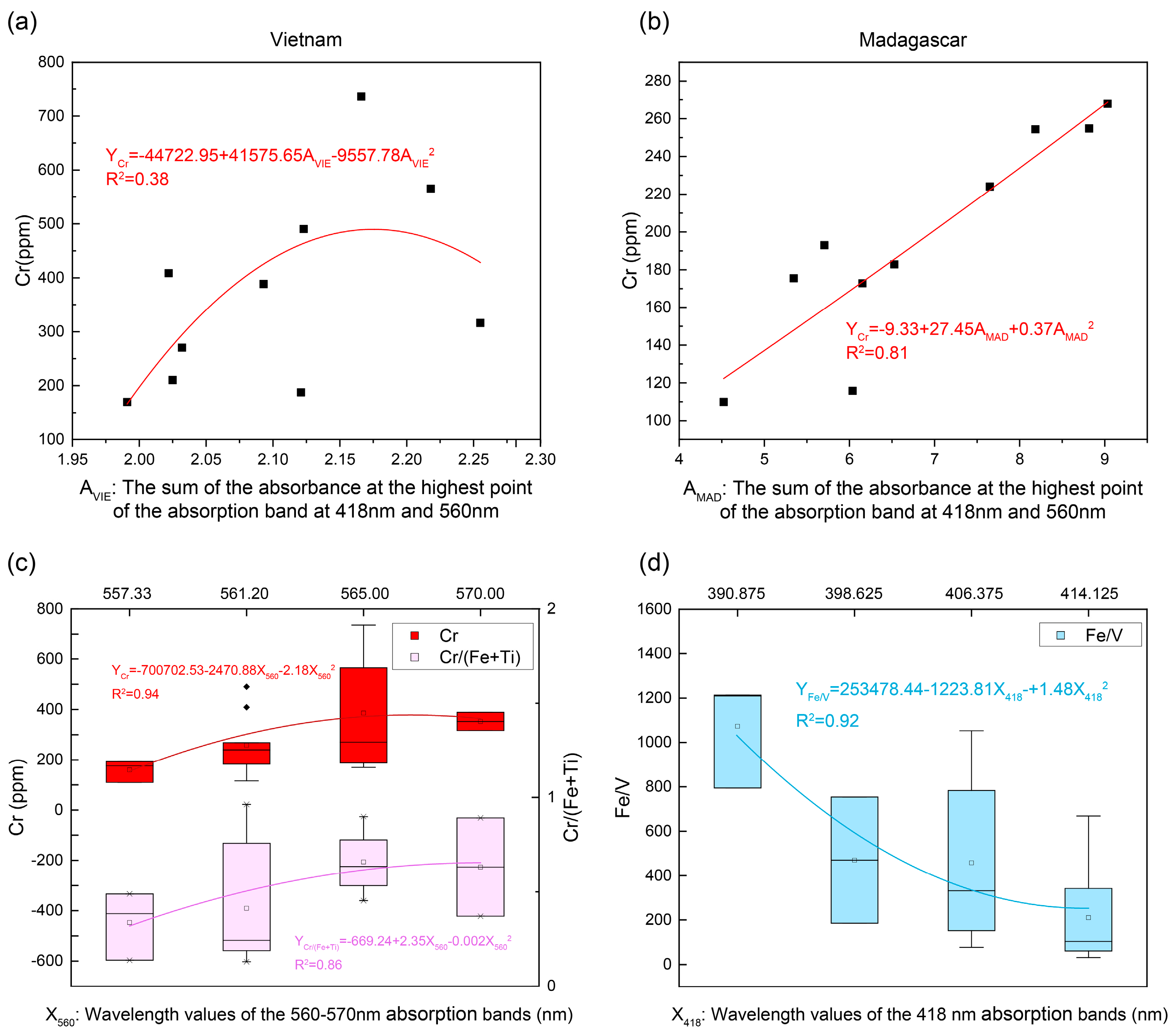

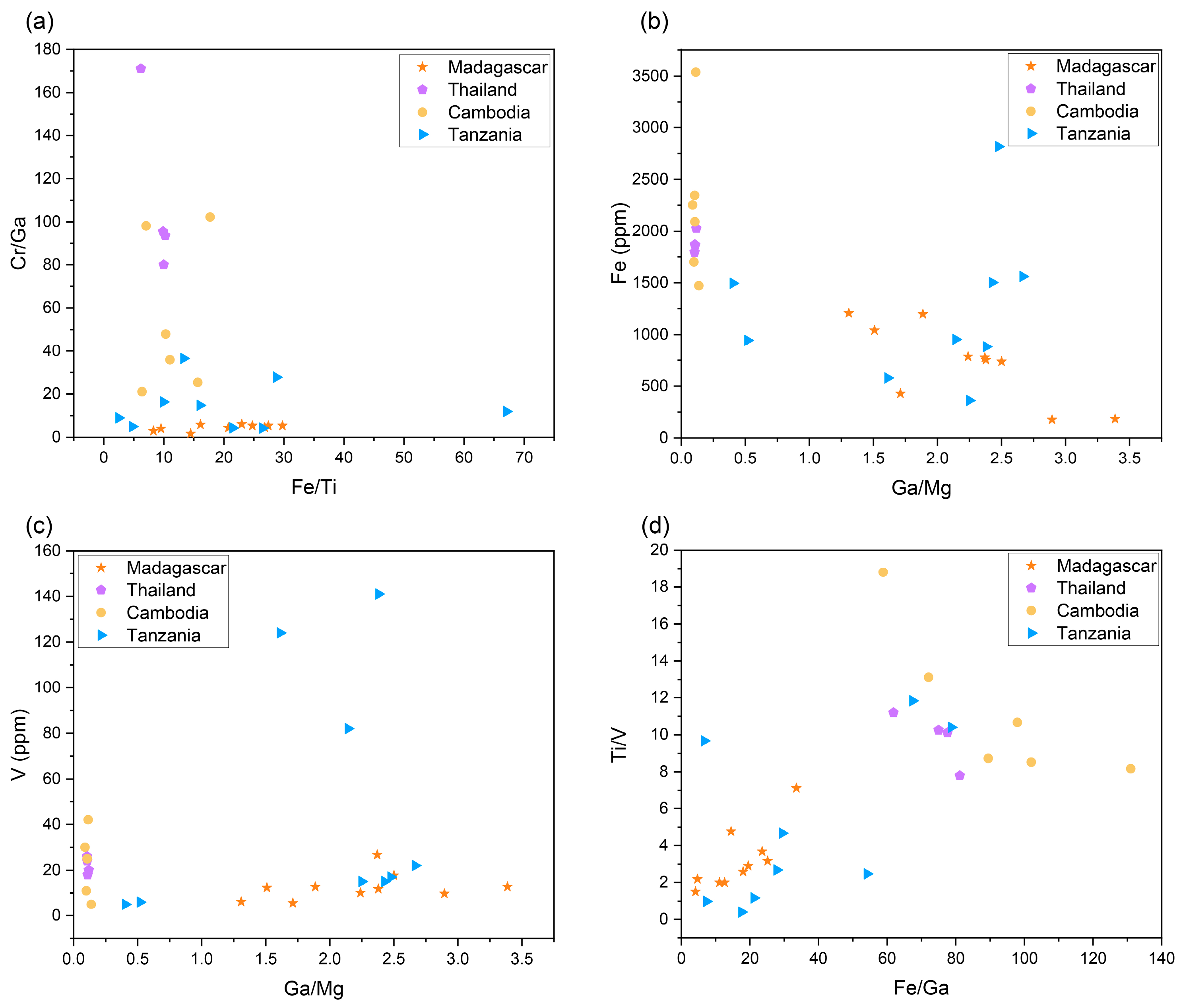
| Madagascar | M-1 | M-2 | M-3 | M-4 | M-5 | M-6 | M-7 | M-8 | M-9 | M-10 |
|---|---|---|---|---|---|---|---|---|---|---|
| Color | Light pink | Pink | Pink | Pink | Purplish pink | Purplish pink | Pinkish purple | Pinkish purple | Pinkish purple | Dark pinkish purple |
| Diaphaneity | Transparent | |||||||||
| SG | 3.94 | 3.95 | 3.97 | 4.04 | 3.94 | 4 | 3.96 | 3.89 | 4 | 3.98 |
| No Ne | 1.765 1.758 | 1.767 1.759 | 1.768 1.760 | 1.768 1.760 | 1.769 1.760 | 1.769 1.761 | 1.768 1.760 | 1.768 1.760 | 1.769 1.761 | 1.767 1.759 |
| Weight (Ct) | 1.06 | 0.79 | 0.74 | 1.04 | 1.09 | 0.96 | 1.10 | 0.99 | 1.56 | 1.59 |
| LW UV | Red fluorescence | |||||||||
| SW UV | Inert | |||||||||
| Vietnam | V-1 | V-2 | V-3 | V-4 | V-5 | V-6 | V-7 | V-8 | V-9 | V-10 |
| Color | Light pink | Light pink | Pink | Pink | Pink | Pink | Pink | Purplish pink | Purplish pink | Purple |
| Diaphaneity | Semitransparent | Semitransparent | Semitransparent | Transparent | Semitransparent | Transparent | Transparent | Transparent | Transparent | Semitransparent |
| SG | 4.1 | 3.98 | 4 | 4.06 | 4.05 | 4 | 4.14 | 4 | 4.12 | 3.78 |
| No Ne | 1.766 1.759 | 1.767 1.759 | 1.766 1.760 | 1.766 1.759 | 1.768 1.760 | 1.767 1.759 | 1.765 1.759 | 1.765 1.759 | 1.765 1.759 | 1.766 1.760 |
| Ct | 0.45 | 0.48 | 0.365 | 0.365 | 0.445 | 0.36 | 0.455 | 0.52 | 0.515 | 0.605 |
| LW UV | Red fluorescence | |||||||||
| SW UV | Inert | |||||||||
| Madagascar | ||||||
|---|---|---|---|---|---|---|
| Trace Elements (ppm) | Mg | Ti | V | Cr | Fe | Ga |
| Range | 10.95–37.85 | 16.10–67.10 | 4.63–38.60 | 8.00–283.98 | 132.10–1281.26 | 27.45–78.95 |
| X | 21.34 | 34.54 | 12.56 | 195.11 | 728.07 | 44.88 |
| S | 4.86 | 6.82 | 3.76 | 35.42 | 222.30 | 7.72 |
| CV | 22.78% | 19.76% | 29.93% | 18.16% | 30.53% | 17.21% |
| Vietnam | ||||||
| Trace Elements (ppm) | Mg | Ti | V | Cr | Fe | Ga |
| Range | bdl–32.88 | 12.51–277.06 | 8.82–48.70 | 132.56–842.88 | bdl–700.86 | 10.25–74.49 |
| X | 10.85 | 82.02 | 21.73 | 374.32 | 167.31 | 29.56 |
| S | 9.18 | 61.21 | 9.54 | 182.57 | 197.22 | 17.14 |
| CV | 84.62% | 74.63% | 43.91% | 48.77% | 117.87% | 58.00% |
| Foggy Appearance | Cloudy Inclusion | Orange Iridescence | Yellowish-Orange Stains | |
|---|---|---|---|---|
| V-1 | √ | √ | √ | √ |
| V-2 | √ | √ | √ | √ |
| V-3 | √ | √ (Thick, fine) | √ (Obvious) | Medi |
| V-4 | Medi | Medi | Medi | × |
| V-5 | √ | √ (Thick, finer) | √ (Obvious) | √ |
| V-6 | Medi | Medi | Medi | Medi |
| V-7 | × | × | × | Medi |
| V-8 | × | √ (Larger particles) | × | × |
| V-9 | × | × | × | √ |
| V-10 | √ | √ | √ | Medi |
| M-(1–10) | × | × | × |
| Trace Elements (ppm) | Mg | Ti | V | Cr | Fe | Ga |
|---|---|---|---|---|---|---|
| Vietnam | 10.85 | 82.02 | 21.73 | 374.32 | 167.31 | 29.56 |
| Yunnan [43] | 29.93 | 63.38 | 70.62 | 4928.08 | 85.71 | 41.83 |
| Myanmar [2] | 64.00 | 454.00 | 287.00 | 3072.00 | 92.00 | 72.00 |
| Trace Elements (ppm) | Mg | Ti | V | Cr | Fe | Ga |
|---|---|---|---|---|---|---|
| Madagascar | 21.34 | 34.54 | 12.56 | 195.11 | 728.07 | 44.88 |
| Thailand [1] | 236.25 | 216.25 | 22.00 | 2905.25 | 1887.00 | 25.75 |
| Cambodia [1] | 226.50 | 232.33 | 23.00 | 1260.83 | 2233.00 | 24.33 |
| Tanzania [1] | 98.14 | 180.42 | 72.82 | 2122.60 | 865.52 | 39.73 |
Disclaimer/Publisher’s Note: The statements, opinions and data contained in all publications are solely those of the individual author(s) and contributor(s) and not of MDPI and/or the editor(s). MDPI and/or the editor(s) disclaim responsibility for any injury to people or property resulting from any ideas, methods, instructions or products referred to in the content. |
© 2025 by the authors. Licensee MDPI, Basel, Switzerland. This article is an open access article distributed under the terms and conditions of the Creative Commons Attribution (CC BY) license (https://creativecommons.org/licenses/by/4.0/).
Share and Cite
Guo, Q.; Li, P.; Wang, M.; Zhao, S.; Yang, S.; Shi, G. Color Mechanism Analysis and Origin Comparison of Pink-Purple Sapphires from Vietnam and Madagascar. Crystals 2025, 15, 229. https://doi.org/10.3390/cryst15030229
Guo Q, Li P, Wang M, Zhao S, Yang S, Shi G. Color Mechanism Analysis and Origin Comparison of Pink-Purple Sapphires from Vietnam and Madagascar. Crystals. 2025; 15(3):229. https://doi.org/10.3390/cryst15030229
Chicago/Turabian StyleGuo, Qiurong, Pengyu Li, Mingying Wang, Siyi Zhao, Sichun Yang, and Guanghai Shi. 2025. "Color Mechanism Analysis and Origin Comparison of Pink-Purple Sapphires from Vietnam and Madagascar" Crystals 15, no. 3: 229. https://doi.org/10.3390/cryst15030229
APA StyleGuo, Q., Li, P., Wang, M., Zhao, S., Yang, S., & Shi, G. (2025). Color Mechanism Analysis and Origin Comparison of Pink-Purple Sapphires from Vietnam and Madagascar. Crystals, 15(3), 229. https://doi.org/10.3390/cryst15030229







